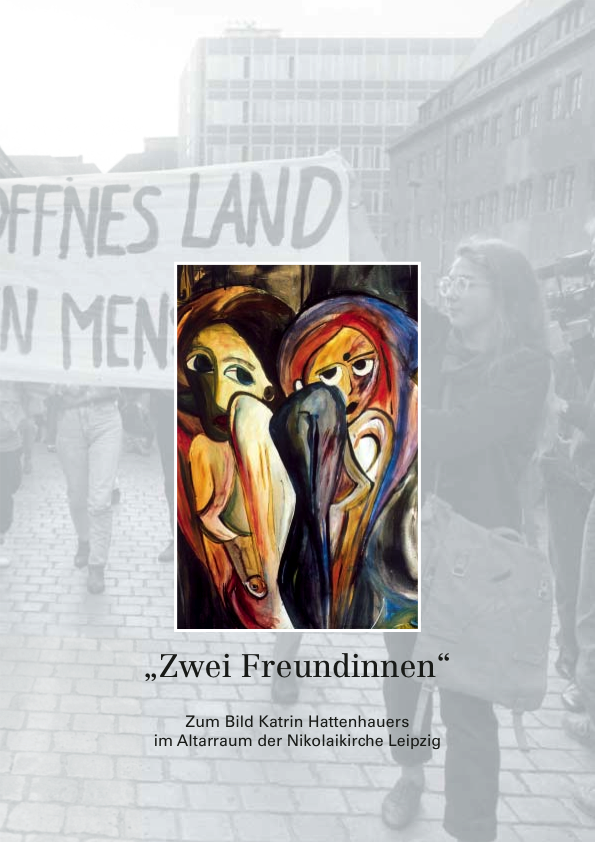

"Zwei Freundinnen (Two Friends)", History of a Painting (1989) of K. Hattenhauer, with contributions of Martin Henker, Christhardt Läpple, Frank Pörner and Ellen Ueberschär, 2014
(from the introduction to the catalogue)
Two women, back to back, pressed against each other, protecting each other. With their eyes wide open, filled with melancholy but brave, they are looking out of the picture into an uncertain future.
The painting shows the artist with her friend. On 4th September the two women carry all their dreams and hopes out of the Nikolai Church into the square outside – in the form of a single ban- ner. This reads: “For an Open Country with Free People”.
More people are joining them for the first Mon- day Demonstration in Leipzig and more banners are being unfurled. Around 600 people are now demonstrating on the square. When the Stasi of- ficers brutally tear down their banner, journalists from the west manage to capture the protest on film.
The television footage of the two young women, who dare to take freedom, who dare to demand freedom for everyone, is broadcast around the world and raises hope in many people. The huge demonstrations, which would change the whole country, have begun.
People came to the Nikolai Church Monday af- ter Monday to pray and dream of the country changing. This is the place where the opposition groups took the demonstrations out of the church and into the public arena: “I came to this place with my friend with our banner: “For an Open Country with free people”. I recognise the two
of us in the painting, two girls who plucked up courage and dared to do what nobody expected. Two girls, who wanted to believe that life could be easy and happy while being full of fear of what might happen. We were young and wanted to change the world. In the end it was the bravery of the people of Leipzig that saved us from paying with our futures.” (Katrin Hattenhauer)
This picture in the Nikolai Church gives a tan- gible sense of how small everything began. The Peaceful Revolution started with individuals who stood together, just like the girls on the painting. Black and grey, fear, little hope in the beginning, yet ready to give their own lives. This painting also speaks of desperation – for nobody knew if there would be a happy end.
Everything could have been for nothing. It is a painting that deals with fear and hope, not yet with victory. Katrin Hattenhauer paints the pic- ture at the start of September 1989, shortly befo- re her imprisonment. Today its place is the chan- cel of the Nikolai Church in Leipzig.
When we speak about the Peaceful Revolution to- day we speak about victory, we speak about ha- ving won and being free. This painting is about how we got there. For Christians and all non- Christians, for the many visitors to the Nikolai Church, this painting could help people under- stand the vital message from 1989: Without fear and without overcoming that fear, self-determi- nation and freedom are not attainable